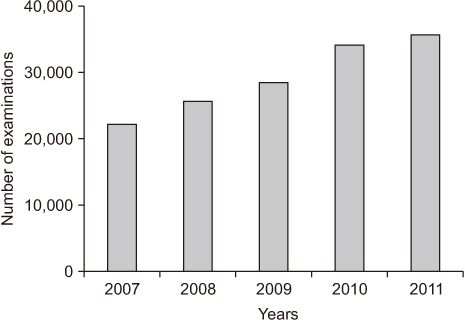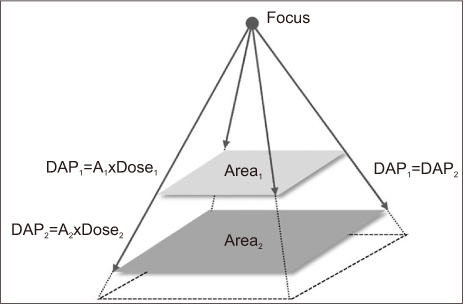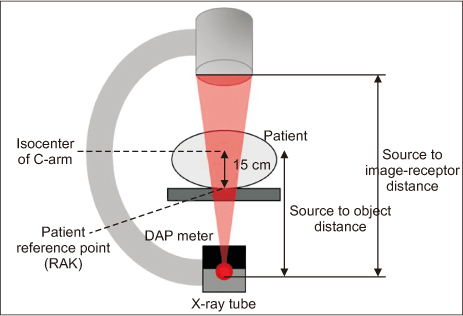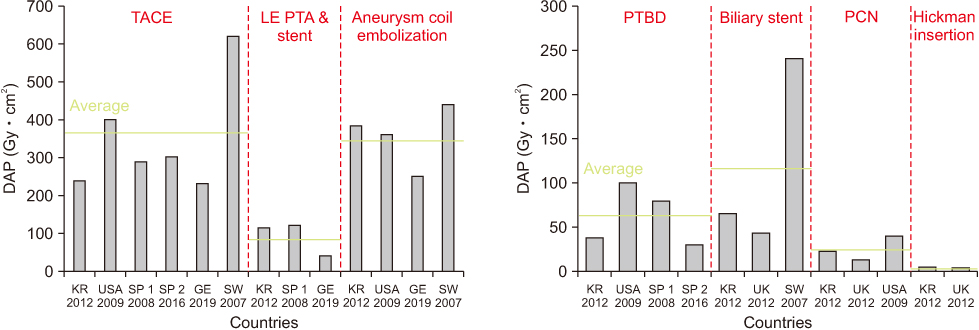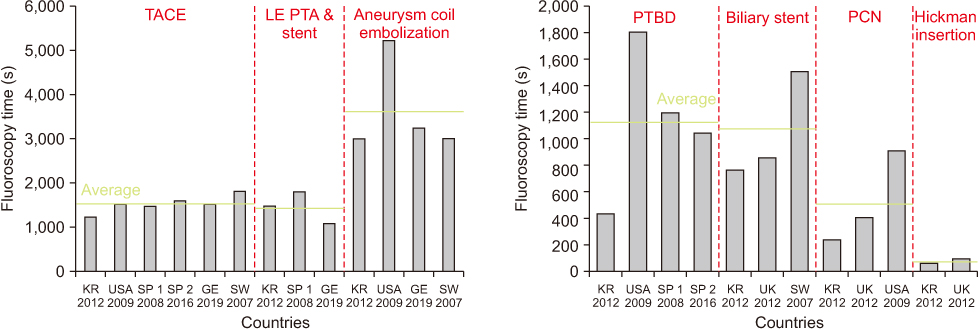Prog Med Phys.
2019 Dec;30(4):75-88. 10.14316/pmp.2019.30.4.75.
Review of National Diagnostic Reference Levels for Interventional Procedures
- Affiliations
-
- 1Department of Nuclear Engineering, Kyung Hee University, Yongin, Korea. kpkim@khu.ac.kr
- KMID: 2468168
- DOI: http://doi.org/10.14316/pmp.2019.30.4.75
Abstract
- Diagnostic reference level (DRL) is employed to optimize the radiation doses of patients. The objective of this study is to review the DRLs for interventional procedures in Korea and abroad. Literature review was performed to investigate radiation dose index and measurement methodology commonly used in DRL determination. Dose area product (DAP) and fluoroscopy time within each major procedure category were systematically abstracted and analyzed. A wide variation was found in the radiation dose. The DAP values and fluoroscopy times ranged 0.01-3,081 Gy·cm² and 2-16,878 seconds for all the interventional procedures, 8.5-1,679 Gy·cm² and 32-5,775 seconds for the transcatheter arterial chemoembolization (TACE), and 0.1-686 Gy·cm² and 16-6,636 seconds for the transfemoral cerebral angiography (TFCA), respectively. The DRL values of the DAP and fluoroscopy time were 238 Gy·cm² and 1,224 seconds for the TACE and 189 Gy·cm² and 686 seconds for the TFCA, respectively. Generally, the DRLs of Korea were lower than those of other developed countries, except for the percutaneous transluminal angioplasty with stent in arteries of the lower extremity (LE PTA and stent), aneurysm coil embolization, and Hickman insertion procedures. The wide variation in the radiation doses of the different procedures suggests that more attention must be paid to reduce unnecessary radiation exposure from medical imaging. Furthermore, periodic nationwide survey of medical radiation exposures is necessary to optimize the patient dose for radiation protection, which will ultimately contribute to patient dose reduction and radiological safety.
Keyword
MeSH Terms
Figure
Reference
-
1. UNSCEAR 2008 Report. Sources and effects of ionizing radiation. UNSCEAR Report. Vienna: UNSCEAR;2010. p. 2008.2. Study on the radiation exposure of the workers of the interventional radiology. Seoul: Ministry of Food and Drug Safety;2013.3. ICRP Publication 60: 1990 Recommendations of the International Commission on Radiological Protection. Ottawa: International Commission on Radiological Protection;1991.4. ICRP Publication 73: Radiological protection and safety in medicine. Ottawa: International Commission on Radiological Protection;1991.5. ICRP Publication 105: Radiological protection in medicine. Ottawa: International Commission on Radiological Protection;2007.6. ICRP Publication 135: Diagnostic reference levels in medical imaging. Ottawa: International Commission on Radiological Protection;2017.7. ICRP Supporting Guidance 2: Radiation and your patient: a guide for medical practitioners. Ottawa: International Commission on Radiological Protection;2002.8. IAEA Safety Series No. 115: International basic safety standards for protection against ionizing radiation and for the safety of radiation sources. Vienna: International Commission on Radiological Protection;1996.9. Evaluation of patient dose in interventional radiology. Seoul: Ministry of Food and Drug Safety;2007.10. Evaluation of patient doses from interventional radiology procedures. Seoul: Ministry of Food and Drug Safety;2012.11. HPA-CRCE-034: Doses to patients from radiographic and fluoroscopic x-ray imaging procedures in the UK - 2010 review. London: Health Protection Agency;2012.12. ICRU Report 74: Patient dosimetry for X rays used in medical imaging. Bethesda: International Commission in Radiation Units and Measurement;2005.13. IAEA Technical Report Series No. 457: Dosimetry in diagnostic radiology: an international code of practice. Vienna: International Atomic Energy Agency;2007.14. IEC 60532: Radiation protection instrumentation - installed dose rate meters, warning assemblies and monitors - X and gamma radiation of energy between 50 keV and 7 MeV. Geneva: International Electrotechnical Commission;2010.15. ICRP Publication 120: Radiological protection in cardiology. Ottawa: International Commission on Radiological Protection;2013.16. Fletcher DW, Miller DL, Balter S, Taylor MA. Comparison of four techniques to estimate radiation dose to skin during angiographic and interventional radiology procedures. J Vasc Interv Radiol. 2002; 13:391–397.
Article17. Chida K, Saito H, Otani H, Kohzuki M, Takahashi S, Yamada S, et al. Relationship between fluoroscopic time, dose-area product, body weight, and maximum radiation skin dose in cardiac interventional procedures. AJR Am J Roentgenol. 2006; 186:774–778.
Article18. NCRP Report No. 168: Radiation dose management for fluoroscopically-guided interventional medical procedures. Bethesda: National Council on Radiation Protection & Measurements;2010.19. Chambers CE, Fetterly KA, Holzer R, Lin PJ, Blankenship JC, Balter S, et al. Radiation safety program for the cardiac catheterization laboratory. Catheter Cardiovasc Interv. 2011; 77:546–556.20. HPA-RPD-029: Doses to patients from radiographic and fluoroscopic X-ray imaging procedures in the UK-2005 review. London: Health Protection Agency;2007.21. Miller DL, Kwon D, Bonavia GH. Reference levels for patient radiation doses in interventional radiology: proposed initial values for US practice. Radiology. 2009; 253:753–764.
Article22. NCRP Report 172: Reference levels and achievable doses in medical and dental imaging : recommendations for the United States. Bethesda: National Council on Radiation Protection & Measurements;2012.23. 97/43/ EURATOM: The European directive on health protection of individuals against the dangers of ionising radiation in relation to medical exposures. Rome: EURopean ATOMic Energy Community;1997.24. Vano E, Sanchez R, Fernandez JM, Gallego JJ, Verdu JF, de Garay MG, et al. Patient dose reference levels for interventional radiology: a national approach. Cardiovasc Intervent Radiol. 2009; 32:19–24.
Article25. Ruiz-Cruces R, Vano E, Carrera-Magariño F, Moreno-Rodriguez F, Soler-Cantos MM, Canis-Lopez M, et al. Diagnostic reference levels and complexity indices in interventional radiology: a national programme. Eur Radiol. 2016; 26:4268–4276.
Article26. Bundesamt für Strahlenschutz: Bekanntmachung der aktualisierten diagnostischen Referenzwerte für nuklearmedizinische Untersuchunge. Salzgitter: Bundesamt für Strahlenschutz;2003.27. Bekanntmachung der aktualisierten diagnostischen Referenzwerte für diagnostische und interventionelle Röntgenuntersuchungen. Salzgitter: Bundesamt für Strahlenschutz;2016.28. Schegerer AA, Loose R, Heuser L, Brix G. Diagnostic reference levels for diagnostic and interventional X-ray procedures in Germany: update and handling. Rofo. 2019; 191:739–751.
Article29. Aroua A, Rickli H, Stauffer JC, Schnyder P, Trueb PR, Valley JF, et al. How to set up and apply reference levels in fluoroscopy at a national level. Eur Radiol. 2007; 17:1621–1633.
Article30. Reference levels for the patient's radiation exposure in cardiology. Helsinki: Radiation and Nuclear Safety Authority;2016.
- Full Text Links
- Actions
-
Cited
- CITED
-
- Close
- Share
- Similar articles
-
- Radiation exposure and its reduction in the fluoroscopic examination and fluoroscopy-guided interventional radiology
- Ultrasound-guided genitourinary interventions: principles and techniques
- Investigation of Prophylactic Antibiotic Usage for Interventional Radiology in Korea
- Interventional Treatment of Low Back Pain
- Perspectives on Fellowship Training Standard in Interventional Neuroradiology

